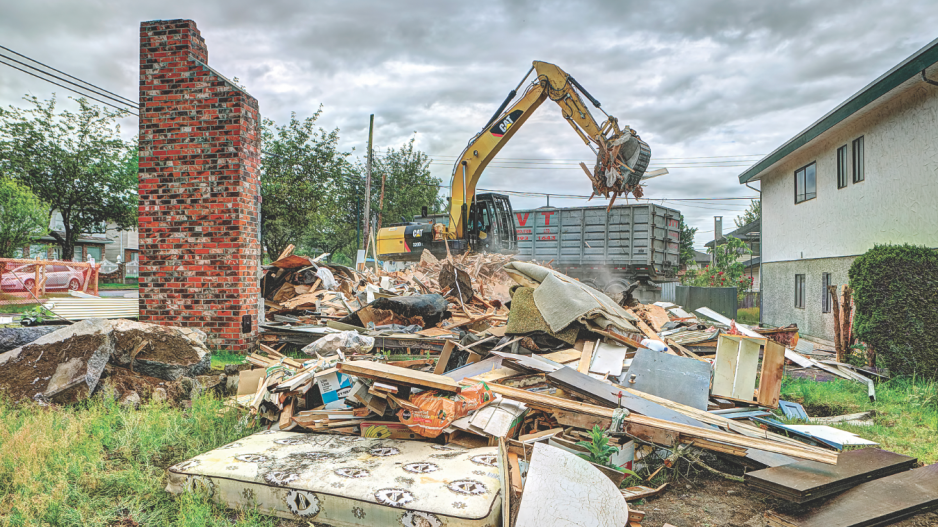Single-family lots in East Vancouver are gradually densifying through city bylaws that allow legal suites and laneway houses, but builders say the ever-increasing cost of Vancouver real estate is making it harder to find properties and turn a profit.
“It looks like every minute house prices are going up, $5, $20, $100,” said Jas Jawanda, owner of JDL Homes, a building company based in Surrey. “You’re seeing that on a continuous basis. … It’s honestly very scary.”
Properties increase in value by around $900,000 when a builder tears down an older bungalow and replaces it with a larger house with a legal basement suite and a laneway house. (Under current city bylaws, laneway houses cannot be sold separately from the original property.)
The trend pushes the price of the built-out property into the $2.4 million range, the kind of hefty price tag once reserved for Vancouver’s west side.
While not every neighbour may appreciate the construction and more crowded lots, single-family lot densification increases rental options in neighbourhoods like Killarney and Renfrew and can fund about half of the $4,000 to $5,000 monthly mortgage required to buy such a property.
“We’re in a huge trend,” said Harjit Atwal, a realtor with Sutton Centre Realty. “This started at the end of last year when prices really started to rise.”
Properties are in such high demand right now that builders often trade properties among themselves in private deals that involve using assignment contracts.
That practice has come under intense scrutiny after media reports earlier this year detailed how some realtors have been using assignments to flip properties before the sale closes and avoid paying B.C.’s property transfer tax – a practice dubbed “shadow flipping” – all while inflating the value of the property.
Read: B.C. to crack down on shadow flipping, track foreign investors
Read: Debate heats up about probability of Lower Mainland's residential real estate bubble bursting
Jawanda said the practice, which has prompted a government crackdown set to start May 16, is common among builders, but he doesn’t buy properties that way because the risk is higher.
“There’s a lot of that going on and it’s getting scarier and scarier,” he said. “There can be a lot of issues that can happen, and I don’t want to get stuck. What if it doesn’t go through? What if the seller decides not to proceed with the sale?”

Using assignments can help smaller builders reduce the risk of holding property, Atwal said.
He doesn’t believe assignments are causing a problem in East Vancouver, but he said it’s gotten out of hand in west-side neighbourhoods like Dunbar and Arbutus.
“I had someone try to sell me an assignment for $1 million more than what they purchased it for in Shaughnessy,” he said.
“People are just taking advantage of it and using it to make a quick buck because there’s such a huge demand and people can’t find anything on MLS [Multiple Listing Service].”
The rapid price acceleration, combined with the City of Vancouver’s lengthy permitting process, has led to another layer of deal-making: it’s common for builders to buy a house, tear it down and begin the permitting process.
They then sell the lot with the permits in place, but not yet paid for, to another builder. Selling the lot with the new house not yet started allows the second builder to avoid paying GST on a new home.
Since it can take up to six months to get permits approved, the builder who does the teardown and permit process can make a smaller but more guaranteed profit of around $40,000. Atwal and Jawanda said the practice does not contribute to price increases, because the first owner is doing valuable work that saves the second builder money.
Meanwhile, the builder who builds out the property makes between $150,000 and $200,000. That contrasts with the windfall received by builders who bought in 2014 and were ready to sell in late 2015: over the course of that year, single-family home prices in Greater Vancouver increased by 25%.
Prices have continued to accelerate: between April 2015 and April 2016, single-family home prices rose by 30%.
Atwal said he knows builders who made $600,000 on a property they bought for $800,000 in 2014 and were able to sell for over $2 million in late 2015.
“What’s happened is that profit is not from the house being built; it’s from the appreciation of the land,” Jawanda said.
All of the people buying the redeveloped properties Atwal has sold in East Vancouver have planned to live in them; many have young families and are buying with a family member such as a sibling who plans to live in one of the other units.
The densification trend is largely not happening on the west side, Atwal said, characterizing buyers in neighbourhoods like Dunbar as wealthy people who would rather use the garage to house an expensive car than build a laneway house.
In Metro Vancouver’s tight market, where bidding wars have become common, builders have to work closely with realtors to secure properties, Jawanda said.
He has developed relationships with several realtors who often let him know about clients who are thinking about selling a home. In return, Jawanda will list the redeveloped property with the same realtor.
“All these places we purchased were through relationships, private deals with the owner,” he said. “It’s such a dog-eat-dog world. I don’t want to get into that bidding process.”
@jenstden




